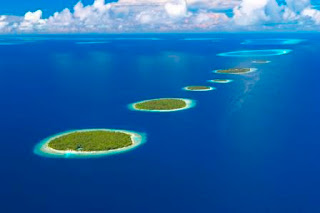Photo: The first tourist resort in Maldives (Kurumba Maldives)
White sandy beaches, clear waters, and waving palms under blue skies make Maldives a tourist destination. Tourism was introduced to the Maldives in the early 1970s. The first two resort Island had a capacity of 280 beds. The first tourist arrived mostly as individuals or small groups. Soon, Maldives began to be recognized as an international tourist destination.
In 1972 the first tourist resort, Kurumba Village, (today a five star hotel), was pioneered by two Maldivian entrepreneurs in association with an Italian investor. A second resort was opened the same year on the island of Bandos. Despite the basic facilities and services, 1,096 tourist arrivals were recorded that year.
Photo: The second tourist resort in Maldives (Bandos Island Resort)
At the start, the country's tourism and its development was for the most part dependent on private initiative. In 1979, the tourism law was enacted, requiring all foreign investments to be registered at the Department of Tourism and Foreign Investment. A tourism master plan was formulated in 1983, setting up guidelines for the overall development of tourism, and identifying tourism zones in different parts of the country. In 1984, the tourism advisory board was created. the department of tourism was upgraded to a ministry in 1988.
The opening of Male' International Airport in 1981 was an important milestone in the travel business. At the early stages, tourism in Maldives was a seasonal industry. As the country opened up further, this seasonal nature of tourism changed. In the early 21st century tourist arrivals were recorded throughout the year. During 1987, a school of hotel and catering was established to meet the manpower requirements of the industry. both government and private sector provide overseas training to those employed in the industry.
The private sector and the government are actively involved in the promotion and marketing of the tourism product. Maldives is represented in all major international travel fairs by both the government and the private operators. The tourist information counter at the Male' International Airport hands out leaflets and other information about the country. The Tourist Information Unit was formed in 1989 to further disseminate information.
The development of tourism has fostered the overall growth of the country's economy. It has created direct and indirect employment and income generation opportunities in other related industries. Today, tourism is the country's biggest foreign exchange earner, contributing nearly a fifth of the GDP.
(by: Current awareness services unit)
Today, more than 900,000 tourists visit the Maldives each year. Former president Ibrahim Nasir, introduced tourism in Maldives.
Wednesday, May 29, 2013
Monday, May 20, 2013
MALDIVES
Maldives is an island
nation in the Indian Ocean consisting of double chain of 26 natural clusters or
atolls. "These atolls form a long, narrow chain in the Indian Ocean
stretching almost 750 kilometers from north to south and covering a total area of
about 90,000 square kilometers. The nearest lands messes are Capes Comorin,
India's southern extremity, 480 kilometers north-east; and Sri Lanka, lying 650
kilometers north-east wards." [Cited: Mysticism in the Maldives, Ali
Husain, Novelty publication 1991].
When we look at the
Maldives, we knew that the majority of its history, Maldives has been polity,
but there are three instances which it was ruled by exterior forces. In the mid
15th century, for fifteen years the Maldives was ruled by Portuguese empire. In
the mid 17th century, for four months Dutch empire ruled, lastly late 19th
century, on the brink of war, the Maldives became a British protectorate from
1887 until 1965.
The Maldives population is
328,536 (2012) inhabits 192 of its 1,192 islands. The capital of Maldives,
Male' city is one of the islands closest to the Hulhule Island were located the
main international airport.
In 1972 Maldives tourism
industry was started with just two resorts with a capacity of about 280 beds.
But today we have more than twenty thousand bed capacity with international
quality standard, Indeed today more than 900,000 tourists visit the Maldives
each year. In addition tourism industry is the backbone of Maldives economy.
After all, I would like to
present you an old Maldivian folk song, “Dheebu Dhivehi Mee”
In thaana script:
Hindhu
emaa kandu therein, Mala fehi ruhgas hedhey
Meemagey ufan bimey, Dheebu
Dhivehi meeKula ali maa Kandu therein,
Ali raiy mui hen dhireyMeemagey ufan bimey, dheebu
Dhivehi meeTranslation:
In horizon of the vast Indian Ocean grow green palms
This is my homeland, this is the Maldives
From the clear blue seas, we grow like pearls,
This is my homeland, this is the Maldives.
In horizon of the vast Indian Ocean grow green palms
This is my homeland, this is the Maldives
From the clear blue seas, we grow like pearls,
This is my homeland, this is the Maldives.
Reference:
Mysticism in the Maldives, Ali Husain, 1991
# Maldives # Beautiful Maldives # Best tourist destination # Number one tourism Industry # Holiday # Invest
Sunday, May 12, 2013
About us "WeMaldives"
"WeMaldives" are two-three people who love their nation (Maldives). We believe, for
a healthy and wealthy nation; there is a responsibility for every person. If
all takes their responsibility, the nation will be in a great happiness.
As we know, tourism
industry is the backbone of our economy, for this reason we are glad to support
and promote this industry by ourselves. We would like to share all information
about our beloved country, Indeed we would like to impress you about Maldives.
In short, "WeMaldives" aim is to offer true information about Maldives,
which including, beauty of nature, economical, political, and social situation
of Maldives, Moreover we will share with you, cultural and historical stories
and events of Maldives.
Subscribe to:
Comments (Atom)




